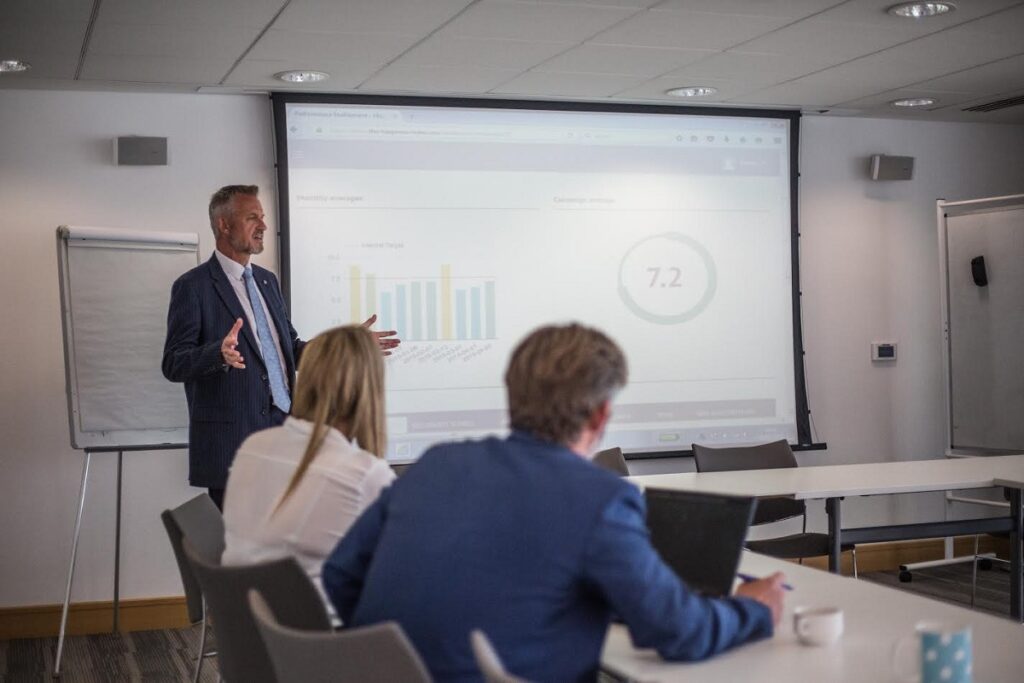The main driving force behind any organisation is its people. The right people analytics programme will help you measure the leadership, vision, happiness and cultural alignment within your organisation.
These metrics have in the past been considered as immeasurable and vague. Consequently, the drive to collect data around them is often discounted. Employee engagement technology allows you to collect numerical data around these metrics – transforming them into measurable and actionable insights. This will help you to develop the people side of your business more effectively.
No one wants to work for a company that cares more about profit than people. Yet, many workers feel like this is their reality. This generally leads to disengagement, which affects productivity, performance and eventually profit.
A need for data
There is a clear need for people analytics within HR, which is evidenced by Deloitte and the CIPD:
- Deloitte conducted a study that revealed only 8% of organisations thought their business was strong in people analytics, despite 75% realising its importance.
- The CIPD found that only 14% of business leaders are happy with the data HR provides. Even more surprisingly, they revealed that only 8% of HR leaders are using any analytics or people measurement tools.
- Business leaders are generally keen for HR to take more of a data-driven approach. However, if you don’t have the right initiatives or tech, how can you provide these numerical insights?
Real-time insights will benefit the board by:
- Attracting and retaining staff.
- Identifying areas for improvement.
- Benchmarking insights against other teams and companies.
- Identifying problems early.
- Creating brand advocates.
- Reducing absenteeism.
- Increasing wellbeing.
- Reducing presenteeism.
- Increasing productivity.
- Reducing recruitment costs.
The problem with annual surveys
Too time-consuming
Traditional annual employee engagement surveys consist of an intimidatingly long list of questions that are sent out once per year. The whole process is very time-consuming, which often leads to people rushing to finish, or proceeding on autopilot. This significantly compromises the validity of their results. By gathering regular feedback via pulse surveys, you will accurately gauge how your people feel in real-time. This will help you to build relevant and timely action plans.
Out-of-date feedback
Most companies will measure their financial metrics daily – P&L, gross margins, sales…So why don’t we gather daily feedback from our people too? Annual surveys are designed to cover the whole year, but most employees will only provide feedback about recent events. By the time you have analysed all of the feedback and created action plans, the data will be out-dated and useless.
Bad analytics, lead to bad insight
Traditional employee engagement methods will transform all your feedback into one large block of data, which is often very difficult to segment and digest. Whereas a well-developed people analytics programme will convert the data into manageable insights – e.g. visuals, tables, word clouds, and comments. We all absorb information in different ways. By adopting multiple visuals and graphics, it will help everyone to fully understand the insights.
By adopting multiple visuals and graphics, it will help everyone to fully understand the insights.
Unreliable data
While many still feel that the annual employee engagement survey is an effective way to gather staff feedback – it cannot pinpoint and fix problems, or provide context around the reasons why you received each score. Advances in HR technology make it easier for business leaders to keep their finger on the pulse of their most important asset – their people. By regularly collecting real-time feedback and turning it into data-driven insights, you will be able to build relevant and effective action plans with ease.
The “2nd P&L”
Often when you walk into a boardroom someone from finance will be reporting on the traditional P&L statement – “How much did we spend?” “What is our budget?” “Are we hitting our targets?” However, there isn’t much that you can associate with the people side of your business.
This is where the ‘2nd P&L’ comes in – a measure of your people and leadership. When combined with the traditional P&L, it is designed to generate a truly 360-degree view of business, that will help the board plan, and prioritise the key actions required to make positive change.
Off the back of this concept, you can collate your insights into a statement, which will help you to deliver a very quick snapshot of performance, in a language that the board will understand.
Here is an example of one of these statements:

This is important for the board, as it will provide them with an overview of the figures in a style that they are accustomed to – allowing them to easily assess the bottom line across these areas. This will ensure that topics like engagement, culture and leadership are always on the agenda.
This is the exact same language used in the boardroom to talk about finance and sales, but now we are discussing metrics that were previously considered as immeasurable. By taking these measurements, and combining them with existing KPIs, you will be able to build strategies for your whole business. This was previously only available with the traditional P&L figures.
By developing a more holistic view of profit and loss, (including the 2nd P&L) businesses will be better-equipped to act quickly to remedy issues that will boost engagement and performance.
Businesses that effectively turn real-time data into tangible actions, will be more agile and productive – leading to an increase in profits.
The main driving force behind any organisation is its people. The right people analytics programme will help you measure the leadership, vision, happiness and cultural alignment within your organisation.
These metrics have in the past been considered as immeasurable and vague. Consequently, the drive to collect data around them is often discounted. Employee engagement technology allows you to collect numerical data around these metrics - transforming them into measurable and actionable insights. This will help you to develop the people side of your business more effectively.
No one wants to work for a company that cares more about profit than people. Yet, many workers feel like this is their reality. This generally leads to disengagement, which affects productivity, performance and eventually profit.
A need for data
There is a clear need for people analytics within HR, which is evidenced by Deloitte and the CIPD:
- Deloitte conducted a study that revealed only 8% of organisations thought their business was strong in people analytics, despite 75% realising its importance.
- The CIPD found that only 14% of business leaders are happy with the data HR provides. Even more surprisingly, they revealed that only 8% of HR leaders are using any analytics or people measurement tools.
- Business leaders are generally keen for HR to take more of a data-driven approach. However, if you don’t have the right initiatives or tech, how can you provide these numerical insights?
Real-time insights will benefit the board by:
- Attracting and retaining staff.
- Identifying areas for improvement.
- Benchmarking insights against other teams and companies.
- Identifying problems early.
- Creating brand advocates.
- Reducing absenteeism.
- Increasing wellbeing.
- Reducing presenteeism.
- Increasing productivity.
- Reducing recruitment costs.
The problem with annual surveys
Too time-consuming
Traditional annual employee engagement surveys consist of an intimidatingly long list of questions that are sent out once per year. The whole process is very time-consuming, which often leads to people rushing to finish, or proceeding on autopilot. This significantly compromises the validity of their results. By gathering regular feedback via pulse surveys, you will accurately gauge how your people feel in real-time. This will help you to build relevant and timely action plans.
Out-of-date feedback
Most companies will measure their financial metrics daily – P&L, gross margins, sales…So why don’t we gather daily feedback from our people too? Annual surveys are designed to cover the whole year, but most employees will only provide feedback about recent events. By the time you have analysed all of the feedback and created action plans, the data will be out-dated and useless.
Bad analytics, lead to bad insight
Traditional employee engagement methods will transform all your feedback into one large block of data, which is often very difficult to segment and digest. Whereas a well-developed people analytics programme will convert the data into manageable insights – e.g. visuals, tables, word clouds, and comments. We all absorb information in different ways. By adopting multiple visuals and graphics, it will help everyone to fully understand the insights.
By adopting multiple visuals and graphics, it will help everyone to fully understand the insights.
Unreliable data
While many still feel that the annual employee engagement survey is an effective way to gather staff feedback – it cannot pinpoint and fix problems, or provide context around the reasons why you received each score. Advances in HR technology make it easier for business leaders to keep their finger on the pulse of their most important asset – their people. By regularly collecting real-time feedback and turning it into data-driven insights, you will be able to build relevant and effective action plans with ease.
The “2nd P&L”
Often when you walk into a boardroom someone from finance will be reporting on the traditional P&L statement – “How much did we spend?” “What is our budget?” “Are we hitting our targets?” However, there isn’t much that you can associate with the people side of your business.
This is where the ‘2nd P&L’ comes in – a measure of your people and leadership. When combined with the traditional P&L, it is designed to generate a truly 360-degree view of business, that will help the board plan, and prioritise the key actions required to make positive change.
Off the back of this concept, you can collate your insights into a statement, which will help you to deliver a very quick snapshot of performance, in a language that the board will understand.
Here is an example of one of these statements:

This is important for the board, as it will provide them with an overview of the figures in a style that they are accustomed to – allowing them to easily assess the bottom line across these areas. This will ensure that topics like engagement, culture and leadership are always on the agenda.
This is the exact same language used in the boardroom to talk about finance and sales, but now we are discussing metrics that were previously considered as immeasurable. By taking these measurements, and combining them with existing KPIs, you will be able to build strategies for your whole business. This was previously only available with the traditional P&L figures.
By developing a more holistic view of profit and loss, (including the 2nd P&L) businesses will be better-equipped to act quickly to remedy issues that will boost engagement and performance.
Businesses that effectively turn real-time data into tangible actions, will be more agile and productive – leading to an increase in profits.









2 Responses
Thanks for this useful
Thanks for this useful article. The 2nd PL looks like a very powerful representation tool,that could indeed have a positive impact on persuading biz leaders to take the matter of employee engagement seriously.
The best source of data on
The best source of data on the impact that employee engagement makes on performance is in the 2 reports published by “Engage for Success.” Unequivocal proof. And yet it’s still so hard to convince the disbelievers – who prefer ‘alternative facts’ perhaps?